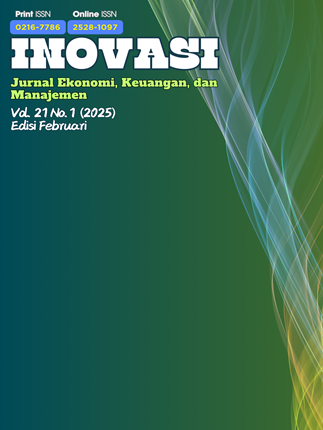A Study on Optimizing Civil Servant Performance: The Role of Employee Engagement and the Merit System through Competency Development at the National Unity and Political Agency of North Kalimantan Province
DOI:
https://doi.org/10.30872/jinv.v21i1.2667Keywords:
Employee Engagement, Merit System, Competency Development, Performance ImprovementAbstract
This study aims to analyze the influence of Employee Engagement and the Merit System on improving the performance of Civil Servants (ASN), with Competency Development as a mediating variable, at the National Unity and Political Agency in North Kalimantan Province. The research employs a quantitative approach using Partial Least Square-Structural Equation Modeling (PLS-SEM) for analysis. Data were collected through questionnaires distributed to 60 respondents selected using purposive sampling. The findings indicate that employee engagement and the merit system do not have a direct significant impact on improving ASN performance. However, both variables exert an indirect significant influence through competency development. Competency development itself has a direct and significant effect on performance improvement, making it a key factor in enhancing the capacity and productivity of civil servants. Employee engagement positively contributes to competency development, indicating that employee involvement plays a crucial role in encouraging active participation in training and development programs. Additionally, the merit system also positively affects competency development, suggesting that implementing a fair and performance-based system can motivate employees to enhance their skills
References
Adams, J. S. (1965). Inequity in Social Exchange. In L. Berkowitz (Ed.), Advances in Experimental Social Psychology (Vol. 2, pp. 267-299). New York: Academic Press.
Aryanti, D., & Kurniasih, D. (2023). Determinasi Sistem Merit Dan Good Governance Terhadap Kualitas Kerja. Majalah Ilmiah Dinamika Administrasi (MIDA), 20(1), 213-226. https://e-journal.unwiku.ac.id/isip/index.php/DA/article/view/92
Bakker, A. B., & Demerouti, E. (2007). The job demands‐resources model: State of the art. Journal of managerial psychology, 22(3), 309-328. https://doi.org/10.1108/02683940710733115
Bakker, A. B., Schaufeli, W. B., Leiter, M. P., & Taris, T. W. (2008). Work engagement: An emerging concept in occupational health psychology. Work & stress, 22(3), 187-200. https://doi.org/10.1080/02678370802393649
Barney, J. (1991). Firm resources and sustained competitive advantage. Journal of Management, 17(1), 99–120.
Becker, G. S. (1964). Human Capital: A Theoretical and Empirical Analysis, with Special Reference to Education. Chicago: University of Chicago Press.
Brown, M. T. (2006). Corporate integrity and public interest: A relational approach to business ethics and leadership. Journal of Business Ethics, 66, 11-18. https://doi.org/10.1007/s10551-006-9050-4
Chairiah, A., Ariski, S., Nugroho, A., & Suhariyanto, A. (2020). Implementasi Sistem Merit pada Aparatur Sipil Negara di Indonesia. Jurnal Borneo Administrator, 16(3), 383-400. https://doi.org/10.24258/jba.v16i3.704
Daryanto, A. (2007). Merit system dalam manajemen pegawai negeri sipil. Jurnal Kebijakan dan Manajemen PNS, 1(2), 1-10. https://jurnal.bkn.go.id/index.php/asn/article/view/13
Dewi, A. L., Khayati, S., Yusuf, N. Y., & Kurniawati, W. I. (2023). Meritokrasi terhadap Pengaturan Kebijakan dan Manajemen Kepegawaian Aparatur Sipil Negara di Lingkup Birokrasi Pemerintahan Kabupaten Konawe Selatan. Arus Jurnal Sosial dan Humaniora, 3(3), 236-241. https://doi.org/10.57250/ajsh.v3i3.318
Febriansyah, H., & Ginting, P. H. (2020). Tujuh Dimensi employee engagement. Prenada Media.
Freiling, J. (2004). A Competence-based Theory of the Firm. Management Revue, 15(1), 27–51. https://books.google.co.id/books?id=Y30tAgAAQBAJ
Ghozali, I. (2018). Aplikasi Analisis Multivariate dengan Program SPSS. Semarang: Badan Penerbit Universitas Diponegoro.
Gultom, D. K. (2014). Pengaruh budaya organisasi perusahaan dan motivasi terhadap kinerja karyawan pada PT. Perusahaan Gas Negara (Persero) Tbk Medan. Jurnal Ilmiah Manajemen dan Bisnis, 14(2), 176-184. https://jurnal.umsu.ac.id/index.php/mbisnis/article/view/194
Hair, J. F., Ringle, C. M., & Sarstedt, M. (2013). Partial least squares structural equation modeling: Rigorous applications, better results and higher acceptance. Long range planning, 46(1-2), 1-12. https://ssrn.com/abstract=2233795
Hanif, H. (2017). Sistem Kompensasi PNS Berbasis Kinerja. Ikonomika: Jurnal Ekonomi dan Bisnis Islam, 1(1), 92-104. https://ejournal.radenintan.ac.id/index.php/ikonomika/article/view/145
Harter, J. K., Schmidt, F. L., & Hayes, T. L. (2002). Business-unit-level relationship between employee satisfaction, employee engagement, and business outcomes: a meta-analysis. Journal of Applied Psychology, 87(2), 268-279. https://psycnet.apa.org/doi/10.1037/0021-9010.87.2.268
Herdiana. (2018). Pengaruh Implementasi Sistem Merit Terhadap Kinerja Pegawai Negeri Sipil (Penelitian pada Sekretariat Daerah Kota Tasikmalaya). Pascasarjana Thesis, Universitas Siliwangi. http://repositori.unsil.ac.id/1667/
Hughes, J. C,, & Rog, E. (2008). Talent management: A strategy for improving employee recruitment, retention and engagement within hospitality organizations. International journal of contemporary hospitality management, 20(7), 743-757. https://doi.org/10.1108/09596110810899086
Kahn, W. A. (1990). Psychological Conditions of Personal Engagement and Disengagement at Work. Academy of Management Journal, 33(4), 692-724. https://doi.org/10.5465/256287
Kasmawati, Y. (2017). Human Capital dan Kinerja Karyawan (Suatu Tinjauan Teoritis). JABE (Journal of Applied Business and Economic), 3(4), 265. https://doi.org/10.30998/jabe.v3i4.1781
Kusmana, D., & Abubakar, M. B. (2023). Efektivitas Peningkatan Kinerja Aparatur Sipil Negara Melalui Sistem Merit (Meryt System) Pada Sekretariat Daerah Kabupaten Bener Meriah Tahun 2019. Jurnal Transparansi Publik (JTP), 2(2), 75-81. https://ojs.unimal.ac.id/jtp/article/view/8695
Locke, E. A., & Latham, G. P. (1990). A Theory of Goal Setting and Task Performance. Englewood Cliffs, NJ: Prentice Hall.
Macey, W. H., & Schneider, B. (2008). The Meaning of Employee Engagement. Industrial and Organizational Psychology, 1(01), 3–30. https://doi.org/10.1111/j.1754- 9434.2007.0002.x
Mangkunegara, A.P. (2015). Sumber Daya Manusia Perusahaan. Cetakan Ke-12. Bandung: Remaja Rosdakarya.
McClelland, D. C. (1973). Testing for competence rather than for" intelligence.". American psychologist, 28(1), 1-14. https://psycnet.apa.org/doi/10.1037/h0034092
McGregor, D. (1960). The Human Side of Enterprise. New York: McGraw-Hill.
Milkovich, G. T., Newman, J. M., & Gerhart, B. (2014). Compensation. McGraw-Hill.
Moko, W., Basuki, A., & Risanto, Y. (2021). Manajemen Kinerja: Teori dan Praktik. Malang: Universitas Brawijaya Press.
Monica, R., & Apriadi, D. (2024). Pengaruh Motivasi dan Disiplin Kerja terhadap Kinerja Karyawan di Bank BCA KCU Banyuwangi. Jurnal Manajemen Dan Bisnis, 2(2), 119-132.
Muhson, A. (2022). Analisis Statistik Dengan SmartPLS: Path Analysis, Confirmatory Factor Analysis, & Structural Equation Modeling. Yogyakarta: Universitas Negeri Yogyakarta Press.
Muspawi, M. (2021). Strategi Peningkatan Kinerja Guru. Jurnal Ilmiah Universitas Batanghari Jambi, 21(1), 101-106. http://dx.doi.org/10.33087/jiubj.v21i1.1265
Nkansah, D., Gyimah, R., Annan, J. K., & Sarpong, D. A. A. (2023). The Effect of Employee Engagement on Employee Performance in Ghana's MSMEs Sector During Covid-19: The Moderating Role of Job Resources. Journal of Social Science, 4(3), 677-697. https://doi.org/10.46799/jss.v4i3.453
Noe, R. A. (2017). Employee Training and Development. New York: McGraw-Hill Education.
Nurofia, F. (2009). Mengenal employee management. Journal Psikologi Maranatha, 6, 1-16. https://repository.maranatha.edu/2598/
Pebriansyah, A., Hattab, S., & Rivai, A. (2024). Kinerja Pegawai Pada Bidang Penelitian Dan Pengembangan di BAPPEDA LITBANG Kabupaten Pasangkayu. Jurnal Ilmiah Research Student, 1(5), 40-52.
Prahalad, C. K., & Hamel, G. (2006). The core competence of the corporation. In Strategische unternehmungsplanung-strategische unternehmungsführung (pp. 275–292). Springer.
Preacher, K. J., & Hayes, A. F. (2008). Asymptotic and resampling strategies for assessing and comparing indirect effects in multiple mediator models. Behavior research methods, 40(3), 879-891.
Rivai, V., & Basri. (2015). Peformance Appraisal: Sistem yang tepat untuk Menilai Kinerja Karyawan dan Meningkatkan Daya Saing Perusahan. Jakarta: PT. RajaGrafindo Persada.
Robinson, D., Perryman, S., & Hayday, S. (2004). The drivers of employee engagement report 408. Institute for Employment Studies, UK, 72. https://api.semanticscholar.org/CorpusID:2886459%7D
Rosmaini, R., & Tanjung, H. (2019). Pengaruh Kompetensi, Motivasi Dan Kepuasan Kerja Terhadap Kinerja Pegawai. Maneggio: Jurnal Ilmiah Magister Manajemen, 2(1), 1-15. https://doi.org/10.30596/maneggio.v2i1.3366
Saks, A. M. (2006). Antecedents and consequences of employee engagement. Journal of Managerial Psychology, 21(7), 600-619.
Sanjaya, D., Apriadi, D., Usman, F., & Islami, R. N. (2023). EFFECT OF WORK STRES TO THE EMPLOYEE’S TURNOVER INTENTION. Journal Management And Business, 1(2), 113-121.
Santoso, H., Mas, N., & Mas’ud, M. (2022). Pengaruh Employee Engagement Dan Kompetensi Terhadap Kinerja Pegawai Melalui Good Governance Sebagai Variabel Intervening (Studi pada Pegawai Kantor Kecamatan Prigen Kabupaten Pasuruan). Jurnal Pendidikan Dasar dan Sosial Humaniora, 1(12), 2471-2490. https://www.bajangjournal.com/index.php/JPDSH/article/view/3799
Sari, R. N. I., & Hadijah, H. S. (2016). Peningkatan kinerja pegawai melalui kepuasan kerja dan disiplin kerja. Jurnal pendidikan manajemen perkantoran, 1(1), 204-214.
Sarwono, J., & Narimawati, U. (2015). Membuat Skripsi, Tesis dan Disertasi dengan Partial Least Square SEM (PLS-SEM). Yogyakarta: Andi.
Schultz, T. W. (1961). Investment in human capital. The American economic review, 1-17. https://www.jstor.org/stable/1818907
Shalahuddin, A. (2018). Pengaruh Kompetensi, Komitmen Organisasional dan Employee Engagement Terhadap Kinerja Pegawai PDAM Tirta Khatulistiwa Pontianak. Jurnal Ekonomi Bisnis Dan Kewirausahaan, 7(3), 202-214. https://dx.doi.org/10.26418/jebik.v7i3.26875
Solong, H. A. (2020). Manajemen Pengembangan Sumber Daya Manusia Menunjang Kinerja Aparatur Berkualitas. Yogyakarta: Deepublish.
Spencer, L. M., & Spencer, S. M. (1993). Competence at Work: Models for Superior Performance. New York: John Wiley & Sons.
Sugiyono. (2017). Metode Penelitian Kuantitatif, Kualitatif, dan R&D. Bandung: Alfabeta.
Ulrich, D., & Lake, D. G. (1990). Organizational Capability: Competing from the Inside Out. New York: John Wiley & Sons.
Umihastanti, D., & Frianto , A. (2022). Pengaruh Dukungan Organisasi dan Employee Engagement terhadap Kinerja Pegawai Badan Kepegawaian Daerah. Jurnal Ilmu Manajemen, 10(1), 219-232. https://doi.org/10.26740/jim.v10n1.p219-232
Wansaga, J. B. (2016). Analisis Merit Sistem, Pengembangan Karir, Keterlibatan Kerja Terhadap Kinerja Karyawan di PT Angkasa Pura 1 (Persero) Manado. Jurnal Berkala Ilmiah Efisiensi, 16(4). https://ejournal.unsrat.ac.id/index.php/jbie/article/view/14133
Zhao, S. (2008). Application of human capital theory in China in the context of the knowledge economy. International Journal of Human Resource Management, 19(5), 802-817. https://doi.org/10.1080/09585190801991145
Downloads
Published
Issue
Section
License
Copyright (c) 2025 Romyansyah, A Juliana, Erick Karunia

This work is licensed under a Creative Commons Attribution-ShareAlike 4.0 International License.






